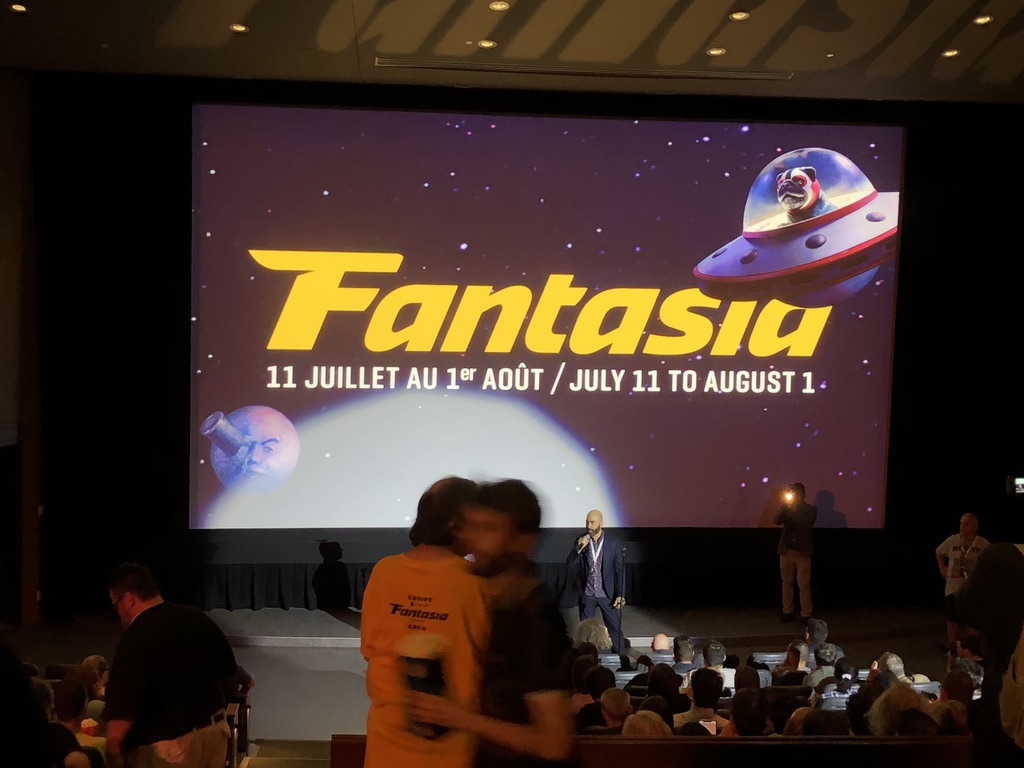Can a film subsist on style alone? That’s the question I found myself returning to during my second week at Fantasia, after seeing many films which had aesthetics that I felt drawn in by, only to be let down by what was underneath them. I have always felt that style should be enough for a film to be great, and this week saw that feeling put to a rigorous test.
For instance, No Mercy is a diverting but unenlightening riff on Taken, set in rural South Korea and following a young woman who takes revenge on a ring of sex traffickers that kidnap her disabled sister. The film’s key mistake, one made by many action films, is that the villains are so detestable and evil, and their evilness sketched in such detailed real-life brutality, that it ceases to be fun watching them get what they deserve. The Prey, a riff on The Most Dangerous Game, doesn’t have this problem: its villains are cartoonish rich Cambodian businessmen who hunt prisoners for sport in the jungle, and the prison’s cruel warden is played by the legendary actor Vithaya Pansingram, seen previously in Only God Forgives. Its hero is an undercover Chinese agent, unjustly arrested, who must fight for survival by getting in touch with his “animal” instincts. The first half is needlessly lengthy and detailed for how paper-thin the story is, but there is some superbly choreographed, deeply engaging action in the film’s back half. Still, I found myself wondering if I responded primarily to the film’s existence rather than its success: in a time when action cinema is dominated almost solely with rubbery CGI and inoffensive bloodless action, being pretty good is perhaps good enough to stand out.
to the degree that I do understand, I do indeed care.
Speaking of genres setting high standards, Idol is a South Korean neo-noir thriller (you should already be salivating) that announces its piercing weirdness from the first line of dialogue and continues to surprise with bitter darkness as its web of plot threads tangle up. Two men, a workman and a politician, begin a game of cat and mouse when the workman’s mentally disabled son is hit bye a car driven by the politician’s son. What occurs in the film’s following 144 minutes are numerous killings and schemes and revelations, so convoluted and indecipherable that I’m not even sure if taking notes would have helped. At one point, two grisly murders are solved, and a character’s face is revealed (to genuine gasps in the audience) and my first reaction to this revelation was “wait, who the hell is THAT?” Fortunately, the story is anchored by a virtuoso style and sense of staging, precise to the point of perverse, peppered with literal blink-and-you’ll-miss-it moments of abstraction, selling a palpable sense of dread. It’s a real shame, then, that after a certain point, I had absolutely no idea what was happening –and judging by the other reviews I’m not alone. But to the degree that I do understand, I do indeed care.
By comparison, the interconnecting, winding stories of G Affairs appear at first to paint a complex-bordering-on-incomprehensible portrait of a “rotting” Hong Kong (in the film’s own words), but as the film goes on it reveals that its story was, in fact, comically simple, and what appeared as complexity was actually just wholly inept storytelling. Following the search for the severed head of a corpse flung into a (seemingly…) random apartment, we follow a teenage girl having an affair with her teacher, the sex worker that her teacher is seeing, a corrupt cop and a classical cellist whose apartment he commandeers for drug deals; all these stories having something to do with the letter G. This is a truly desperate film which clings to hyperactive, hyper-obnoxious stylistics to distract from its fundamental emptiness and its mean, regressive sense of morality. Avoid it like hell when you see it in the “Because you watched Pulp Fiction” tab on Netflix a year from now.
Speaking of films with dumb titles, Killerman is the most tantalizing sort of terrible movie: beginning with an incredible opening and suddenly getting worse by the scene, culminating with what is surely one of the dumbest twist endings in recent memory (a teaser: it makes the film’s already dumb title about ten million times dumber). Liam Hemsworth stars as Moe Diamond, who runs a money-laundering scheme with his partner Skunk (Emory Cohen, serviceable as a collection of scumbum ornaments) until one unlucky day when a deal gone bad results in a car crash that leaves Moe with amnesia. There is a borderline-incomprehensible meta plot regarding congressmen and corrupt cops and the incomparable Zlatko Burić as a wheezing, bloated drug kingpin, but it amounts to comically little for how much time is spent on it.
This film’s world premiere was met with a cheering, engaged audience, and I can honestly see why some might take to it: there is a great score, there are gorgeous shots of New York, shockingly brutal moments of violence, and some genuinely thrilling action sequences, but they’re all just garnishes and distractions for a film with a rotten core. This type of tight, subjective, character-focused caper basically lives or dies on the strength of the lead performer, and Hemsworth is, frankly, not capable of giving this movie anything it requires, not pathos, not anger, not grit or insanity, and not even a half-decent New York accent. It only truly succeeds in one respect: the fantastic opening sequence, in which Moe meanders around the diamond district exchanging crystals for cash and dirty money for clean checks, shot on gritty and crisp Kodachrome, is a great way to hype yourself up for the upcoming dirtbag-in-the-diamond-district picture Uncut Gems, made by two filmmakers who did this exact type of film superlatively last year.
We Are Little Zombies is the hyperactive feature debut of filmmaker Makoto Nagahisa, who also shot the genuinely masterful short film And So We Put Goldfish In The Pool, even weirder than the title makes it sound. It’s an enjoyable story of a band of Tokyo pre-teens who unite because of their common inability to cry at the funerals of their parents (which all occurred at the same time). Shot in orderly storybook fashion, edited as quick as can be, and glazed with 8-bit affectations, it’s comparable to both Wes Anderson and Edgar Wright, though those comparisons sell the unique style short. It’s just a shame that the odd, absurd touches of Goldfish are flattened out (literally) here, instead, the film reaches for a sense of melancholy that never truly manifests.
the film continues to resist easy definition even in retrospect.
There were many films last week that grabbed me but only two that truly satisfied. The first, Mystery of the Night, tells a twisted fairy tale set in the colonial Philippines, surrounding the sins of Spain’s empire being paid for after generations, and surreal, supernatural flourishes sharing space with historical ones. The style perfectly suits the film’s slow, sensitive storytelling: shots linger patiently on crowded jungles and ornate Spanish houses, tension builds and builds and then the film cuts without resolution. When the camera does move, it’s an event, inspiring more interest than all the severed heads in the world. Of course, we’re being conspicuously primed for a hyperviolent and explosive conclusion, but our expectation is both delivered upon and challenged; the film continues to resist easy definition even in retrospect.
The other film is Jennifer Reeder’s KNIVES AND SKIN, which will be the subject of an article to come. For now, I’ll say that it’s the film that provided me with an answer to my question: can a film subsist on style alone? Yes, but only a unique one.


